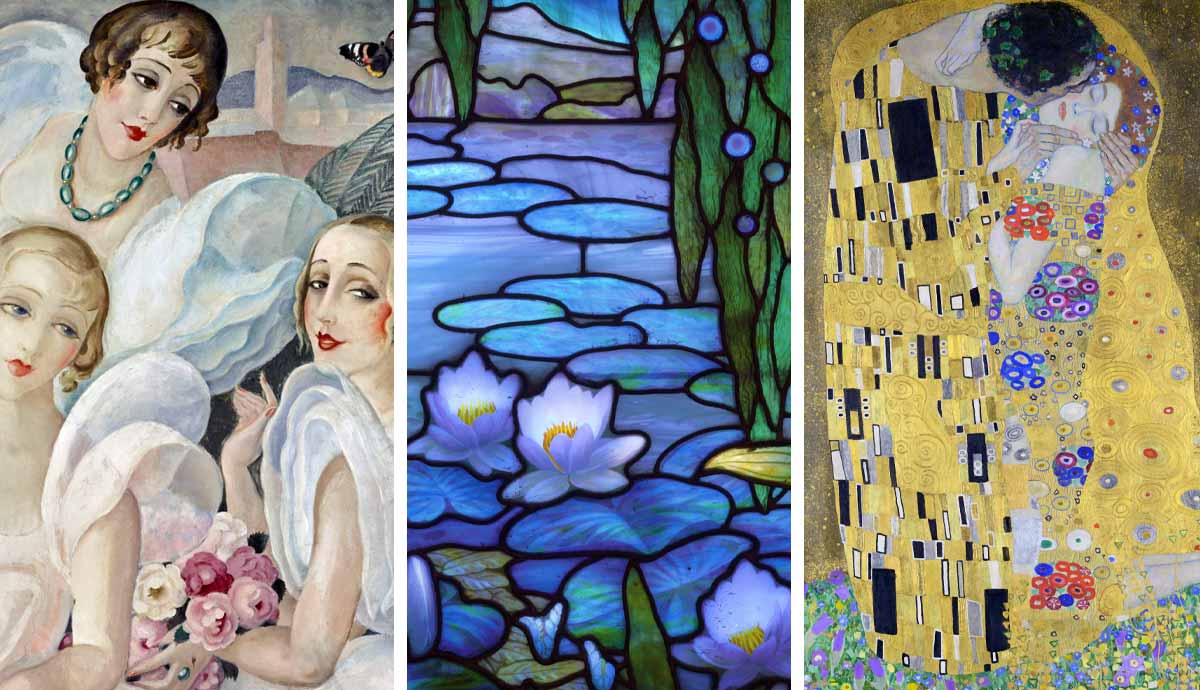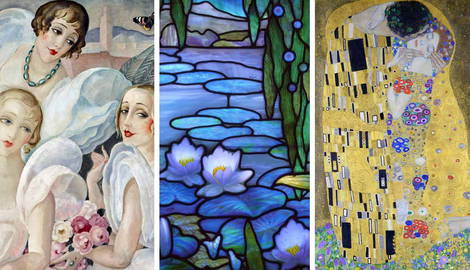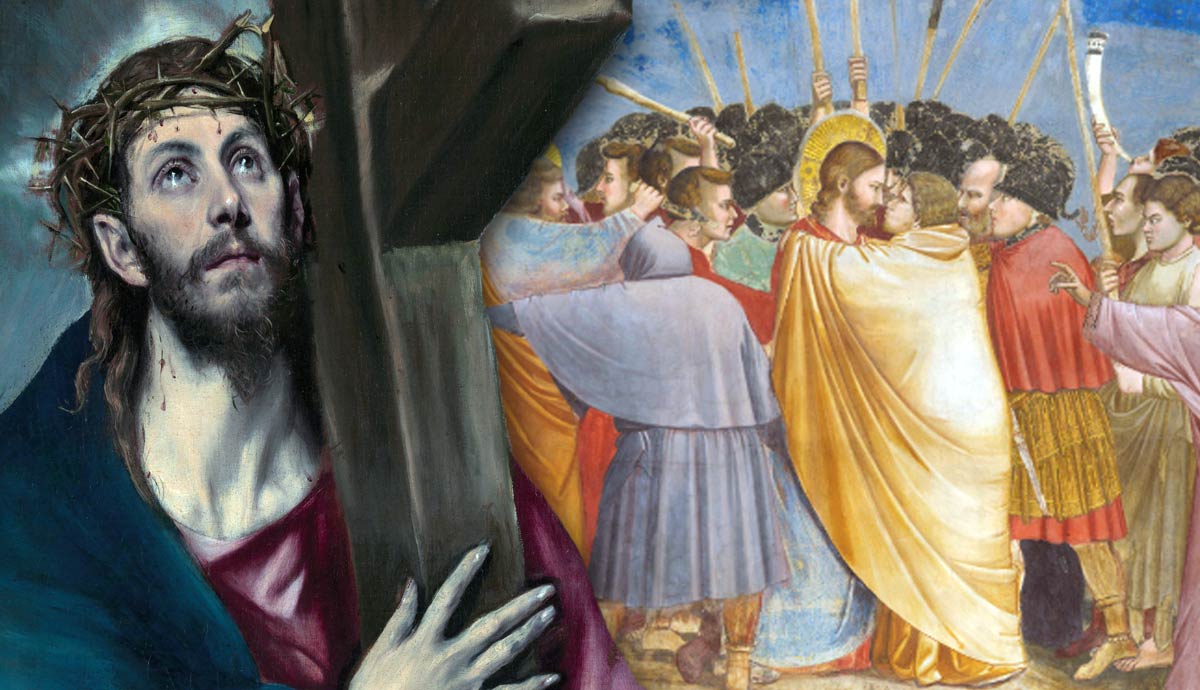
Art Nouveau developed between the 1880s and World War I in Western Europe and the USA. It was inspired by nature and characterized by sinuous lines. It was a movement that developed across the visual arts that aimed to break away from traditional art. It was closely linked to the Arts and Crafts and Aesthetic movements, as well as to Japonisme. Read on to discover the beauty of Art Nouveau through the work of ten artists.
1. Gustav Klimt

Art Nouveau was present in the field of painting, with the Austrian artist Gustav Klimt being a prominent figure. He was born in 1862 in Baumgarten, Austria, into a large family and studied architecture and painting. He embraced symbolism and was a founding member of the Vienna Secession movement, which aimed to promote young artists, showcase foreign works, and seek alternative expressions against academism.
After the death of his father and brother, Klimt began to formulate a new personal style, which was deeply influenced by Japanese art. He used to depict works focused on the female body and erotic themes. After facing negative criticism for his murals at the University of Vienna, he retired from public commissions and found success during his “golden phase.” This period was marked by his introduction to Byzantine mosaics, which inspired him to use gold leaf in his works with worship and sensuality themes.
His iconic painting, The Kiss, is representative of this phase and is believed to depict his partner, Emilie Louise Flöge, or possibly another model with whom he was having an affair. Despite the intense criticism of his work, Klimt became a prominent figure in the art world and his works are considered to be among the most important works of his time.
2. Gerda Wegener

Gerda Wegener was a Danish illustrator and painter born in 1885. She graduated from the Royal Danish Academy of Fine Arts and gained fame in Paris for her fashion illustrations. Wegener was best known for her Art Nouveau and Art Deco depictions of modern femme fatales. Her images often portrayed women posing or engaging in artistic activities such as theater, literature, and dance. Later, she created works that depicted women embracing their seductive power or participating in sexual activities. This bold artwork was categorized as lesbian erotica and was published in underground art books.
Wegener challenged traditional gender roles and sexual identities through her art, often painting men with slender bodies and soft lines. Her favorite model was her first husband, Einar Wegener, who later became Lili Elbe. The couple married in 1904 and lived a bohemian lifestyle in Paris, where Lili began to dress as a woman. After Lili’s death in 1931 from complications related to her sex reassignment surgery, Gerda remarried and moved to Marrakech. She continued to paint until her divorce in 1936, after which she returned to Denmark. Over the years, the story of Gerda and Lili gained widespread recognition, inspiring David Ebershoff’s best-selling book The Danish Girl and its film adaptation.
3. Ethel Reed

Art Nouveau was a period during which graphic design and illustration thrived. Ethel Reed was a prominent American graphic designer known for her distinctive Art Nouveau posters and illustrations in the 1890s. Born in Newburyport, Massachusetts, in 1874, she was largely self-taught and gained recognition in Boston, where she produced significant works from 1895 to 1897 before briefly working in London.
Reed was remarkably prolific while in Boston. From 1895 to 1897, she designed a large number of important book posters, in addition to creating illustrations, covers, and endpapers. Her style was unique and deeply influenced by the whiplash-curve sensibility of Art Nouveau. Many of Reed’s illustrations feature female figures, often surrounded by objects and intricate forms that seem to convey hidden and possibly illicit meanings. After becoming engaged to the artist Philip Hale in 1897, she traveled to England for a book poster project and then to Ireland, where she mysteriously disappeared. Reed received recognition from major art institutions in the United States, including the Metropolitan Museum of Art and the Museum of Modern Art.
4. Aubrey Beardsley

Aubrey Beardsley was a prominent artist known for his brief yet remarkable career. Born in 1872 in Brighton, England, he demonstrated artistic talent from an early age. He studied at the Westminster School of Art, where he focused on drawing and was influenced by Dante Gabriel Rossetti and Edward Burne-Jones, and Japanese Art.
His work embodies a rejection of traditional moral and aesthetic conventions, embracing both decadence and provocation. Beardsley’s sophisticated style features elegant lines and classical subjects infused with a subversive and often obscene tone that creates a blend of visual pleasure and discomfort. He gained recognition after illustrating Oscar Wilde’s Salomé in 1894, with famous works such as The Stomach Dance, a black-and-white print on Japanese vellum showing Salomé performing the dance of the seven veils. She is scantily clad with exposed breasts and stomach, adorned with a peacock feather headdress. To her right, roses float in mid-air, while in the lower left corner, a grotesque figure drools and plays a stringed instrument, with a phallus barely concealed in his clothing. His illustrations received mixed reviews and were characterized as both fantastic and grotesque.
5. Louis Comfort Tiffany

The stained glass and glass industry was a defining feature of the Art Nouveau period. Louis Comfort Tiffany, born in 1848, was an American artist and designer known for his contributions to the Art Nouveau movement, particularly in stained glass. He was a member of the Associated Artists group, which included other prominent designers such as Lockwood de Forest and Candace Wheeler. Tiffany showed a passion for art from a young age and studied under George Inness and Samuel Colman before training in Paris.
In 1875, he began experimenting with stained glass, which led to the establishment of the Tiffany Glass Company three years later. The company was renowned for the innovation of Favrile glass, celebrated for its iridescence and distinctive colors and the iconic lamps. His work gained international acclaim, especially in central Europe. Tiffany received a special commission from President Chester A. Arthur to redecorate the White House and designed a chapel for the 1893 World’s Columbian Exposition in Chicago. From 1896 to 1900, he produced remarkable Favrile pieces, solidifying his status in the Art Nouveau movement. In 1919, he established the Louis Comfort Tiffany Foundation to support art students and promote artistic education.
6. Jacques Gruber

Jacques Gruber, born in 1870 in Sundhouse, France, was a renowned glass designer who initially worked for the crystal studio Daum Frères in Nancy before establishing his own stained glass studio. He trained under Théodore Devilly and studied at the École des Beaux-Arts in Paris, where he was mentored by Gustave Moreau.
After returning to Nancy in 1893, Gruber taught at the École des Beaux-Arts and worked as a decorative artist for Daum Frères until 1897, playing a significant role in the company’s transition towards artistic glass production. He later devoted his efforts to stained glass, creating notable works for various buildings, including the Chamber of Commerce and Industry in Meurthe-et-Moselle.
As one of the founders of the École de Nancy, Gruber made a substantial contribution to the art of stained glass, becoming known for his innovative designs featuring opalescent glass windows adorned with floral motifs. His remarkable work, the Lily Pond Window, was showcased at the Salon de la Société Nationale des Beaux-Arts in Paris in 1912. This piece features three layers of acid-etched opalescent glass panes and incorporates undulating leaves, which enhance the plant forms and add depth to the design.
7. Victor Horta

The Art Nouveau movement certainly included elegant interior design. Victor Horta, born in Ghent in 1861, was one of the most influential architects and interior designers of the 1890s. He was a pioneer of the Art Nouveau style. His innovative designs combined structural rationality with curvilinear decorations inspired by nature, resulting in artistic buildings that paid attention to every detail.
Horta studied at the Ghent Academy of Fine Arts and worked with architect Alphonse Balat. His architectural heyday began with the Tassel House, designed in 1893 for scientist Emile Tassel. This building was considered the foundation of Art Nouveau in Brussels, featuring a prominent metal structure, integrated decoration, and ample natural light. It was intended for a bachelor living with his grandmother while hosting friends and conducting scientific work. Horta further developed this style in the Solvay House (1894) and the Van Eetvelde House (1895), as well as in public works like La Maison du Peuple (1895). Despite his initial fame, Horta’s work became simpler over time, leading to fewer commissions. In the 1920s, he shifted his focus to urban projects, most notably the concert hall Le Palais des Beaux-Arts (Bozar) (1920), which is now regarded as his greatest masterpiece.
8. Louis Majorelle

Louis-Jean-Sylvestre Majorelle, commonly known as Louis Majorelle (1859-1926), was a prominent French decorator and furniture designer, famous for his work in the Art Nouveau style. As vice-president of the École de Nancy, he played a major role in the transformation of furniture design. His creations are highly regarded and can be compared to those of famous furniture artists such as André Charles Boulle and Charles Cressent.
Majorelle skillfully combined domestic and exotic woods, crafting pieces that resembled a painter’s palette. He used materials such as oak, walnut, and rosewood to achieve soft hues and intricate patterns. One notable piece, Armoire which forms part of a bedroom suite, exemplifies his craftsmanship and innovation, as it features gold-plated lily-shaped bronze brackets and floral embellishments. It is considered one of the most important examples of Art Nouveau furniture in the United States and it was shown at the 1909 East of France International Exposition in Nancy. There, customers were able to select individual items from the gallery or from an illustrated catalog.
9. Antoni Gaudí

During the Art Nouveau period, many architects honed their skills. Antoni Gaudí was a Catalan architect renowned for his contributions to Catalan Art Nouveau and his distinctive architectural style. Born in 1852 in Reus, he was raised in a family of boilermakers, which influenced his design skills and spatial awareness. Due to his delicate health as a child, he developed a deep appreciation for nature, which became a core element of his architectural philosophy.
He moved to Barcelona in 1870 to pursue his studies in architecture, graduating in 1878. He went on to complete several iconic projects, including Park Güell, Casa Batlló, and La Sagrada Familia. In his later years, he became increasingly focused on his work and deepened his religious beliefs.
Casa Batlló was part of a larger urban development plan that transformed the street into a prominent avenue in Barcelona by the 20th century. Initially constructed in 1877, Gaudí redesigned the building between 1904 and 1906 after it was purchased by Josep Batlló. His redesign preserved the existing structure while enhancing its artistic and functional qualities, showcasing the modern architectural trends of his time
10. Hector Guimard

Hector Guimard was a French architect and a key figure of the Art Nouveau movement. He gained early recognition with the design of the Castel Beranger, the first Art Nouveau apartment building in Paris. Guimard is best known for the decorative glass and iron canopies at the entrances to the Paris Metro, which feature elegant, decorative curves. Between 1890 and 1930, he designed around fifty buildings and over a hundred metro entrances.
Initially, his work experienced a decline in popularity in the 1910s and many of his designs were demolished by the 1960s, leaving only two original Metro entrances. However, his reputation was revived by his acquisitions by the Musée d’Art Moderne de Paris and his contributions were recognized for their originality and significance. Guimard designed Metro entrances using cast iron and concrete, with distinctive lettering and a standardized aesthetic.
Most entrances were simple structures called entourages, while some were more elaborate, such as the Porte Dauphine, with a glass roof known as édicules. Entrances often featured Métropolitain signs adorned with lights that resembled flowers or eyes. Despite their initial unpopularity, Guimard’s works are celebrated today as emblematic elements of Parisian architecture.
Art Nouveau artists revolutionized the art world with their innovative styles, curvilinear forms, and emphasis on organic and natural motifs. Their radical approach paved the way for many artists and left a lasting impact on art, architecture, and design.









